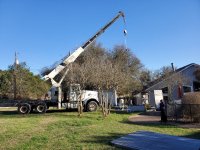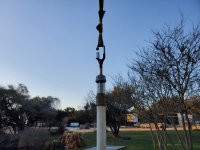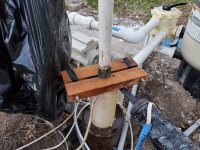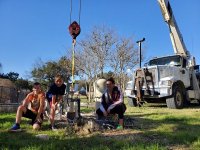Greetings. Great forum that has been extremely informative to me in my quest to replace the submersible pump in my 700 foot well after the historical winter storm in Texas. Attached some pictures to share of my setup with some setup hacks that I devised as a DIY-er.
For 2 weeks been without water for my family of 5 and not a single well company has been able to schedule a visit & only 2 have called me back. Needless to say, I have taken matters into my own hands. Plus, I just happen to own a 20 ton 40 foot crane truck which comes in handy. The pump failed likely due to a frozen exposed casing at or near ground level. I now realize the value in installing a pump saver!! Wish I knew this a month ago.
So I am in the process of pulling my pump. See pictures...this is a family affair and great experience for my kids. Was able to pull 140 feet of PVC down pipe yesterday evening. I will finish it up tomorrow morning.
I would greatly appreciate some feedback and best practices. Here are some of my most pressing questions? Oh, the well was drilled in 1997 or almost 25 years ago in my town of Dripping Springs, TX. The well pump directly feeds a 300 gal holding tank & was normally pushing 10 GPM when I purchased the property 5 years ago.
1) Should I reuse the threaded 20 foot PVC pipe 1-1/4" sections? So far, VISUALLY the pipe looks to be in very good condition. I am leaning on replacing with no good supportive logic other than being an OCD engineer.
2) Should I reuse the brass or possibly bronze couplers? If not, is stainless preferred? Again, if I replace the PVC, I was planning the same for couplers but stainless this time.
3) On same note, the submerged wiring to the pump? So far the wiring looks to be in very good condition. I did notice one 6" section that was originally heavily taped. I assume the installers possibly knicked the outer sheath (I will remove tape to inspect closely). My plan is to reuse due to the absorbent cost of 700 feet of new wiring for a 2hp pump.
4) I read a thread about secondary check valves but seemed to lack overall consensus. Should I install an additional check valve just above the pump? I saw that Simmons SS check valves are highly recommended. My personal conclusion on this subject was that most do NOT recommend a secondary check valve outside of the one internal to the pump. But I did see a video by Wendell Lee Well Services where they recommend installing 2 additional valves above the pump (seems to be a very legitimate well service company).
5) Any reason to go with another pump manufacturer other than Goulds?
6) Is mil-spec 2" well tape still the current preferred method to tape the electrical line to the down pipe? I ask as it seems that stainless zip ties might be a lot quicker and possibly more effective long term? Having said this, my nearly 25 year old tape is holding excellent.
7) Finally, is a relief valve needed at the well cap? The original system has one installed. If so, how do I size the valve appropriately?
I am probably missing something. If anyone has any additional tips or suggestions, much appreciated. I am very good at figuring things out with help from the internet & helpful forums like this. But first time to deal with a well to this magnitude and certainly don't want to learn the hard way!
Thank you so very much! Devin
For 2 weeks been without water for my family of 5 and not a single well company has been able to schedule a visit & only 2 have called me back. Needless to say, I have taken matters into my own hands. Plus, I just happen to own a 20 ton 40 foot crane truck which comes in handy. The pump failed likely due to a frozen exposed casing at or near ground level. I now realize the value in installing a pump saver!! Wish I knew this a month ago.
So I am in the process of pulling my pump. See pictures...this is a family affair and great experience for my kids. Was able to pull 140 feet of PVC down pipe yesterday evening. I will finish it up tomorrow morning.
I would greatly appreciate some feedback and best practices. Here are some of my most pressing questions? Oh, the well was drilled in 1997 or almost 25 years ago in my town of Dripping Springs, TX. The well pump directly feeds a 300 gal holding tank & was normally pushing 10 GPM when I purchased the property 5 years ago.
1) Should I reuse the threaded 20 foot PVC pipe 1-1/4" sections? So far, VISUALLY the pipe looks to be in very good condition. I am leaning on replacing with no good supportive logic other than being an OCD engineer.
2) Should I reuse the brass or possibly bronze couplers? If not, is stainless preferred? Again, if I replace the PVC, I was planning the same for couplers but stainless this time.
3) On same note, the submerged wiring to the pump? So far the wiring looks to be in very good condition. I did notice one 6" section that was originally heavily taped. I assume the installers possibly knicked the outer sheath (I will remove tape to inspect closely). My plan is to reuse due to the absorbent cost of 700 feet of new wiring for a 2hp pump.
4) I read a thread about secondary check valves but seemed to lack overall consensus. Should I install an additional check valve just above the pump? I saw that Simmons SS check valves are highly recommended. My personal conclusion on this subject was that most do NOT recommend a secondary check valve outside of the one internal to the pump. But I did see a video by Wendell Lee Well Services where they recommend installing 2 additional valves above the pump (seems to be a very legitimate well service company).
5) Any reason to go with another pump manufacturer other than Goulds?
6) Is mil-spec 2" well tape still the current preferred method to tape the electrical line to the down pipe? I ask as it seems that stainless zip ties might be a lot quicker and possibly more effective long term? Having said this, my nearly 25 year old tape is holding excellent.
7) Finally, is a relief valve needed at the well cap? The original system has one installed. If so, how do I size the valve appropriately?
I am probably missing something. If anyone has any additional tips or suggestions, much appreciated. I am very good at figuring things out with help from the internet & helpful forums like this. But first time to deal with a well to this magnitude and certainly don't want to learn the hard way!
Thank you so very much! Devin




